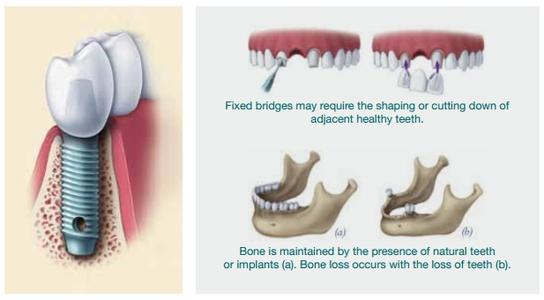Dental Implants; Sinus Lift
An Implant is a small “anchor” made of safe titanium that is inserted into jawbone to replace root of missing tooth. Dental Implants have many attributes such as:
1) Looks and feels like natural teeth
2) Simple surgical procedure with a 95% Success Rate
3) Stops jaw bone deterioration
4) Eliminates denture sore spots
5) You will experience comfortable eating -no more slipping or rubbing of your denture
6) You will have more confidence smiling-no more slipping or movement of your denture
7) Safe and medically proven to replace missing teeth
8) Cost is similar to bridgework and eliminates need to grind down healthy teeth for a bridge
9) Helps face retain its natural shape
10) Implants, if taken care of properly, can last a lifetime. Whereas dentures and bridges need to be remade approximately every 7-15 years
Are you a candidate for implants?
If you’re healthy enough to have a tooth extracted, you’re probably healthy enough to have an implant – whether your missing teeth are the result of injury, disease, or decay. General good health and adequate bone in the jaw are the key requirements. Dr. Casey can tell you if implants are right for you.
Maxillary Sinus Lift and Bone Graft
What Is It?
A sinus lift is surgery that adds bone to your upper jaw in the area of your molars and premolars. It’s sometimes called a sinus augmentation. The bone is added between your jaw and the maxillary sinuses, which are on either side of your nose. To make room for the bone, the sinus membrane has to be moved upward, or “lifted.” A sinus lift usually is done by a specialist. This could be either an oral and maxillofacial surgeon or a periodontist.
What It’s Used For
A sinus lift is done when there is not enough bone height in the upper jaw, or the sinuses are too close to the jaw, for dental implants to be placed. There are several reasons for this:
-
Many people who have lost teeth in their upper jaw — particularly the back teeth, or molars — do not have enough bone for implants to be placed. Because of the anatomy of the skull, the back of the upper jaw has less bone than the lower jaw.
- Bone may have been lost because of periodontal (gum) disease.
-
Tooth loss may have led to a loss of bone as well. Once teeth are gone, bone begins to be resorbed (absorbed back into the body). If teeth have been missing for a long time, there often is not enough bone left to place implants.
-
Tooth loss may have led to a loss of bone as well. Once teeth are gone, bone begins to be resorbed (absorbed back into the body). If teeth have been missing for a long time, there often is not enough bone left to place implants.
-
The maxillary sinus may be too close to the upper jaw for implants to be placed. The shape and the size of this sinus varies from person to person. The sinus also can get larger as you age.
Sinus lifts have become common during the last 15 years as more people get dental implants to replace missing teeth.
